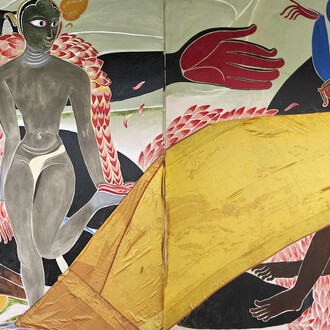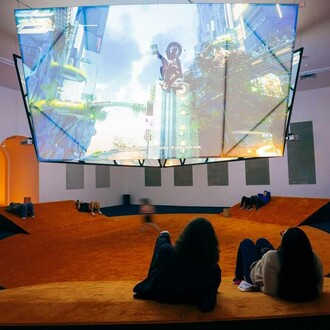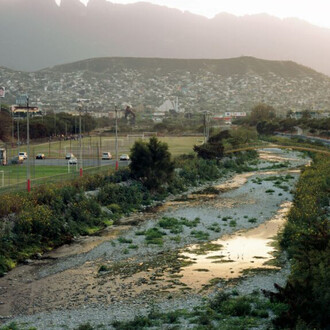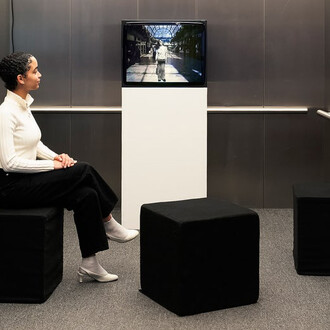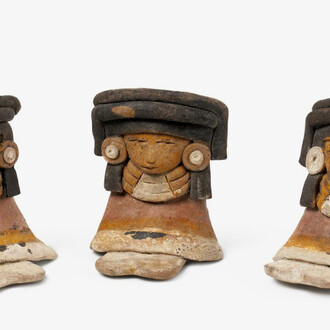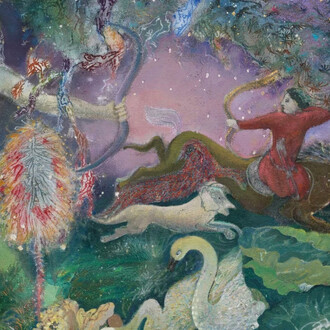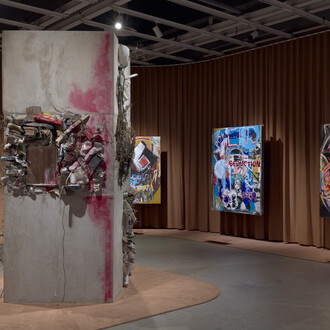Fiona Curran's work reflects an interest in the representation of landscape and the place that the ‘natural’ holds in relation to advances in technology and the increased blurring of the boundaries between the natural and the artificial. Digital media now enable access to local, regional, national and international sites simultaneously; territorial boundaries dissolve as one geographical location is caught up in another, distances collapse due to the compression of the near and the far. The speed of technology can be seen to contribute to a sense of fragmentation and a blurring of the perceptual field as images are illuminated and colours intensified. The instantaneous and dematerialized ‘real-time’ screen reality begins to replace the ‘real-space’ presence of objects, places and people.
Curran’s works reveal a recurring utopian impulse, formal idealism and sense of escapism that registers in a palette borrowed from the computer screen and advertising. There's a sense of spatial precariousness as objects and forms collapse, are broken down and reassembled. Paintings break away from their frames becoming sculptures and existing works are re-placed and dis-located through new configurations and assemblages of value. Materials are stacked, hung and folded; they jostle and balance against different surfaces. Splinters of the natural world appear in the use of wooden veneers alongside plastics, glass, fabric and hand-stitched fragments. Found photographs that reference real spaces and sites suggest a tangible sense of place and these sit alongside more formal, abstract works that engage with unseen but 'sensed' geographies.
In ‘Waiting for the Perfect View’ the assemblage of paintings, found objects, weathered carpets and Ostrich feather palm trees stand like some kind of postcard from the future. Everything natural has receded in this dystopic SF vision, artifice after a mass ecological extinction. Balanced between the old ideas of the end of the world and some kind of future hotch-potch imagination of what that once was the vignette appears as out of time as the rags and wreckage that Walter Benjamin has us believe to be the material of history in the making. This is the character of Beach Fatigue, Fiona Curran’s malady of images.
It’s no coincidence that the black and white aerial photograph from which Curran sources the road lined with palm trees appears to be of military origin. The survey of bikini atoll before and after the nuclear tests comes to mind. Within it the strange linguistic accident of nuclear tests and the raciest of beach-wear come together in one ultramodern hit that marks the end of history, the end of convention, and potentially, at least, the end of everything. Such an entropic aggregate of meaning would no doubt have been at the heart of JG Ballard’s fiction. Only the end would then come slowly creeping up like the Beach Fatigue that plagues the residents of his Vermillion Sands short stories, a pathology that corresponds to this affective entropy and dissipated energy of waiting for the inevitable tide to wash everything away into oblivion. Washed away unto a Pale Horizon perhaps - where we witness the plastic, artificial imaginary of a ‘natural’ sunset and animated waves trapped in a mechanical delirium loop.
Carslaw St. Lukes Gallery
137 Whitecross Street, St. Lukes
London EC1Y 8JL United Kingdom
Ph. +44 (0)20 74903667
info@carslawstlukes.com
Opening hours
Thursday - Saturday
From 12pm to 6pm or by appointment







